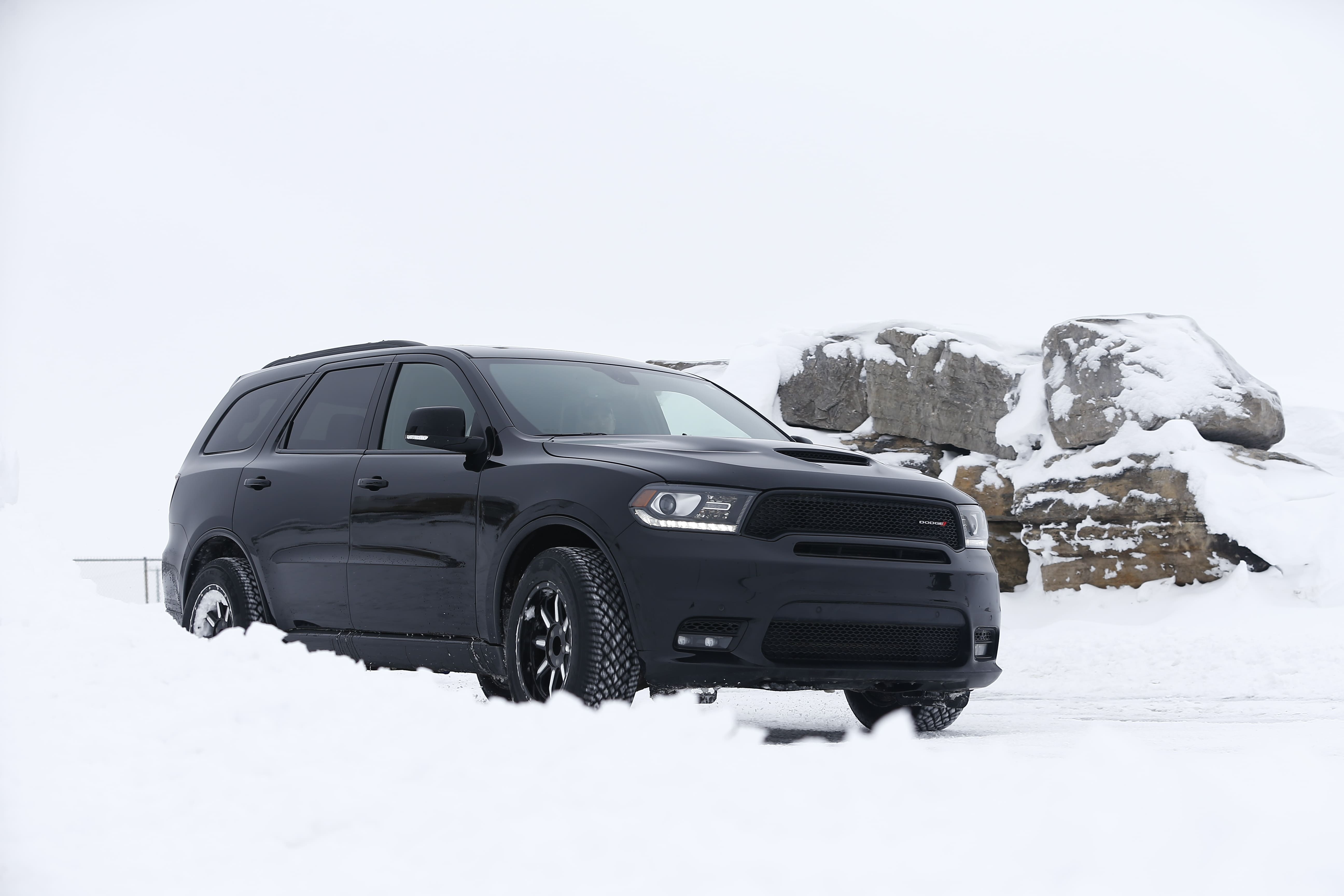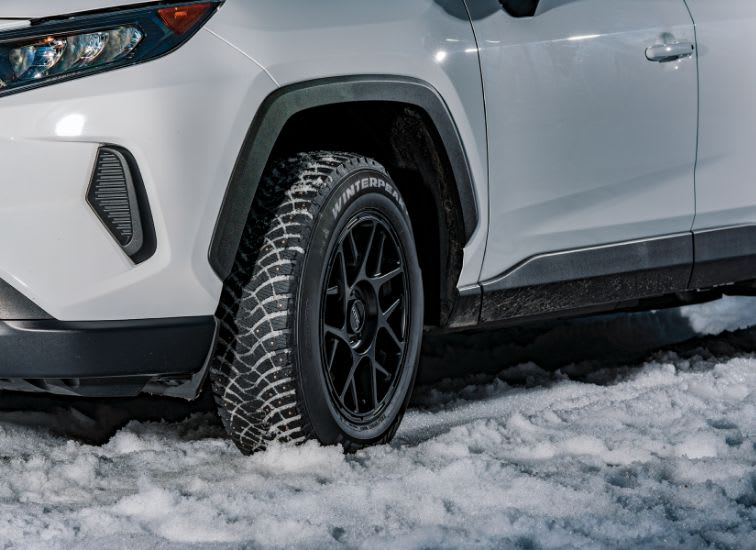Tire Buying Guides
Best price guarantee
Tire replacement coverage
24/7 roadside assistance
Easy returns

Winter driving presents unique challenges that can test the limits of both driver and vehicle. As the temperature drops and snow and ice accumulate on the roads, having the right tires becomes increasingly important for maintaining safety and control behind the wheel.
While all-season tires are designed to provide acceptable performance in a variety of conditions, they may not be sufficient when winter weather is at its worst. This is where winter tires, also known as snow tires, come into play offering superior traction, handling, and braking capabilities in cold and snowy conditions.
In this article, we'll explore the key differences between winter tires and all-season tires, helping you make an informed decision about whether investing in a set of winter tires is the right choice for your vehicle and driving needs.
What are winter tires and how do they differ from all-season tires?
Winter tires, as the name suggests, are specifically engineered to provide optimal performance in cold weather conditions, including snow, ice, slush, and even dry roads when temperatures dip below 45°F. The key to their superior performance lies in their unique tread compound and design.
Unlike all-season tires, which are made from a harder rubber compound to provide longer tread life and acceptable performance across a range of conditions, winter tires are crafted using a softer, more pliable rubber compound. This allows them to remain flexible at lower temperatures, providing better grip and traction on cold surfaces.
In addition to their specialized tread compound, winter tires feature distinct tread patterns designed to channel snow, slush, and water away from the tire's contact patch. The tread blocks are covered with numerous small slits known as sipes, which create additional biting edges for improved grip on slippery surfaces.
All-season tires, on the other hand, offer a balance of performance characteristics suitable for mild weather conditions. They prioritize factors such as tread life, fuel efficiency, and quiet operation, making them a popular choice for many vehicle owners. However, their jack-of-all-trades nature means they don't excel in any particular area, especially when it comes to extreme winter weather.
The Importance of Tread Compound
One of the most significant differences between winter tires and all-season tires is their tread compound. Winter tires are made from a softer rubber that remains pliable at lower temperatures, allowing them to conform to the road surface and maintain grip even when the mercury drops.
All-season tires, in contrast, are made from a harder rubber compound that provides longer tread life and better performance in warmer conditions. However, as temperatures approach freezing, this harder compound begins to stiffen and lose its ability to provide adequate traction.
Tread Design: Sipes and Biting Edges
Winter tires also feature a unique tread design that sets them apart from all-season tires. Their tread patterns are characterized by larger gaps between the tread blocks, which help to channel snow and slush away from the tire's contact patch. This design element helps to reduce the risk of hydroplaning and maintain traction on wet and slushy roads.
Additionally, winter tires are covered in numerous small slits known as sipes. These sipes create additional biting edges that can grip the road surface, even when it's covered in a thin layer of snow or ice. The high density of sipes on winter tires allows them to provide unparalleled traction in challenging winter conditions.
All-season tires, while they may have some siping, typically feature fewer biting edges and a less aggressive tread pattern. This design is better suited to providing a quiet, comfortable ride and longer tread life, but it falls short when it comes to delivering the same level of winter performance as dedicated snow tires.
Are winter tires really necessary?

In areas where winters bring frequent snowfall, icy roads, and frigid temperatures, winter tires prove invaluable. These tires deliver a level of safety and stability that surpasses what all-season tires can offer under severe winter conditions. Their unique construction allows them to remain flexible and provide reliable traction, empowering drivers to handle snow-covered and icy roads with enhanced confidence.
Vehicles with all-wheel drive still gain a significant advantage from winter tires. While all-wheel drive improves traction by powering all four wheels, it doesn't enhance the tire's grip on the road itself. Winter tires, however, work in harmony with all-wheel drive systems, offering the necessary grip and control to tackle slippery winter roads effectively. This synergy results in improved safety and performance, even in challenging driving environments.
Winter tires excel on more than just snowy days. Their advanced tread patterns and rubber compounds ensure superior handling and braking on all cold surfaces, whether wet, slushy, or dry. This versatility allows drivers to face the variable nature of winter weather with assurance, knowing their tires are well-equipped to manage whatever conditions the season presents.
How do winter tires improve safety and performance?

Winter tires significantly enhance safety and performance by addressing the specific challenges of cold weather driving. These tires feature advanced tread designs tailored for winter conditions. Instead of the typical tread design, winter tires have a pattern that effectively ejects snow and slush from the contact patch. This ensures that the tire maintains a direct connection with the road, even in adverse weather.
Another crucial aspect of winter tires is their enhanced stopping capability. The specialized rubber compound remains flexible at low temperatures, providing the necessary grip to bring vehicles to a halt more effectively on icy or snowy surfaces. This increased traction is vital for avoiding potential accidents during sudden stops or emergency situations, offering drivers the confidence that their vehicle will respond promptly and safely.
Winter tires also elevate driving dynamics by offering improved stability and control. The intricate tread pattern provides numerous edges that grip the road, boosting the vehicle's ability to handle turns and maintain its path on slick surfaces. This improvement in handling means that drivers experience a more secure and predictable ride, reducing the risk of losing control during challenging maneuvers. Through these features, winter tires ensure that vehicles perform optimally in winter conditions.
Can I get away with using just two winter tires?
Opting for only two winter tires might initially seem like a smart way to save money, but this approach can introduce serious handling and stability challenges. When winter tires are installed solely on the drive axle, the mismatch with the other tires results in an imbalance in traction. This disparity can become dangerous during maneuvers like braking or turning, where the vehicle's stability might falter.
Vehicles are designed to perform best when traction is evenly distributed across all four tires. Installing only two winter tires can lead to inconsistent grip, causing the rear end to slide out or the front to lose steering capability, particularly on icy roads. This imbalance can make it difficult to maintain control, increasing the likelihood of accidents.
Combining winter tires with all-season tires can also disrupt the vehicle's overall dynamics. The differences in tread design and rubber composition mean each tire type reacts differently to varying road conditions. This mismatch can lead to erratic handling, especially in mixed conditions like slush or light snow. For optimal safety and performance, using a complete set of four winter tires is advisable, ensuring consistent traction and handling for winter driving.
Certainly! Let's ensure the new section provides fresh insights without repeating content from the article.
Are winter tires expensive and how long do they last?

Purchasing winter tires may initially seem like a significant outlay, yet they offer invaluable returns in terms of safety and enhanced performance during adverse winter conditions. Their ability to provide superior grip and control can help avoid accidents, making them a prudent investment for any driver navigating snowy or icy roads. This upfront expense, when balanced against the protection of your vehicle and its passengers, is often justified.
Winter tires are designed to endure several seasons, though their longevity depends on various factors. The distance traveled, especially on rugged winter terrain, plays a critical role in determining their lifespan. However, thoughtful usage and care can significantly extend their service life, allowing drivers to benefit from their enhanced safety features over multiple winters.
Proper maintenance is key to maximizing the lifespan of winter tires. Regular rotation helps ensure even wear, preventing premature tread loss. Storing the tires in a climate-controlled environment during warmer months is essential to preserve their condition. Exposure to heat and sunlight can lead to hardening and cracking, reducing their effectiveness when cold weather returns. By adhering to these maintenance practices, drivers can ensure their winter tires remain reliable and efficient for years.
When should I install and remove my winter tires?
Deciding when to switch to winter tires involves understanding seasonal temperature changes. It's wise to install winter tires when the temperatures start to hover consistently around freezing. This ensures that their specialized tread and rubber compounds can perform optimally on cold and potentially slippery roads. Late fall often marks the beginning of these conditions, making it an appropriate time to transition from all-season or summer tires to winter ones.
As the chill of winter fades and warmer weather emerges, it's advisable to revert to summer or all-season tires. The softer rubber of winter tires can degrade more quickly in warmer conditions, leading to increased wear and reduced effectiveness for future seasons. Ensuring your vehicle is equipped with tires suited to the current climate not only preserves your winter tires but also enhances safety and performance during warmer months.
Regional weather variations can influence the timing of these changes. In areas where winter lingers or arrives earlier, adjusting your tire swap schedule is key. Staying informed about local weather patterns and seeking advice from tire experts can help tailor your tire strategy to specific driving conditions, ensuring optimal safety and performance year-round.
How do I choose the right winter tires for my vehicle?
Selecting winter tires begins with understanding your vehicle's needs. Check the owner's manual or the tire information sticker inside the driver's door as these contain crucial details on the correct tire size and specifications for your vehicle. Following these guidelines ensures that the tires you choose will fit properly and perform optimally, maintaining your vehicle's safety and handling in winter conditions.
With the specifications in hand, explore and compare options from well-regarded tire manufacturers. Consider tread design and the specific rubber compounds used, as these directly impact how well a tire performs on snow and ice. Look into reviews and ratings that provide real-world feedback on tire performance. Selecting tires that have demonstrated superior winter capabilities can enhance both safety and driving experience.
Your driving habits and the conditions you typically face are key factors in your decision. For frequent travel through heavy snow or icy roads, prioritize tires with deep tread patterns and robust grip. For those with long highway commutes, a tire that offers a balance of traction and comfort might be more suitable. Consulting with tire experts can provide tailored advice, ensuring you choose a tire that fits your unique driving environment and needs.
While winter tires require an initial investment, their ability to provide enhanced safety, performance, and peace of mind in challenging winter conditions makes them a worthwhile consideration for many drivers. By understanding your vehicle's needs, driving habits, and local weather patterns, you can make an informed decision about whether winter tires are the right choice for you. If you're ready to explore winter tire options and find the best deals, we invite you to shop for tires online with us today.
Ready to find the perfect tires?
Search By